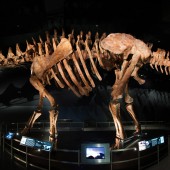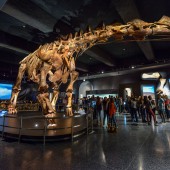The Titanosaur Permanent Exhibition by Amnh 3d Design Team |
Home > Winners > #49614 |
 |
|
||||
| DESIGN DETAILS | |||||
| DESIGN NAME: The Titanosaur PRIMARY FUNCTION: Permanent Exhibition INSPIRATION: When paleontologists uncover a new fossil, they rarely find all of the bones. This life-sized Titanosaur skeleton was recreated using the 84 bones discovered in Argentina, along with computer generated models of the missing bones based on analysis of the dino’s close relatives. The well-preserved nature of these bones, the sheer enormity of the creature, and the novelty of its discovery were all inspiration for recreating the skeleton to display it for the general public. UNIQUE PROPERTIES / PROJECT DESCRIPTION: Fossils of this specific Titanosaur, one among a diverse group of sauropod dinosaurs, were discovered in the Argentinian desert in 2014. This particular dinosaur, which is so new that it has not yet been officially named by paleontologists, is thought to be the largest creature ever to walk the Earth. It stands at 46 feet tall, 122 feet long and would have weighed in at around 70 tons. The American Museum of Natural History casted and mounted a replica of the dinosaur and brought five of the original fossils to the exhibit, in an effort to include the public in this ground breaking discovery. OPERATION / FLOW / INTERACTION: Since the Titanosaur extends past the confines of a single room, visitors can enter from either entrance of the Wallach Orientation Center to gaze upon the enormity of this dinosaur. By entering one end of the exhibit, visitors can see the Titanosaur looking down on them, crouching in a position as if to bow at its guests. Should spectators enter the hall through the other entrance, they are greeted by the Titanosaur’s massive tail hung gracefully in the air. Visitors then have the opportunity to learn more about the creature through the numerous displays surrounding the dino, including a BBC/PBS video explaining the process of finding the Titanosaur and creating its cast. Additionally, in one section of the hall are four real fossils from the Argentine excavation site for visitors to examine. The displays, both digital and natural, serve to educate guests about the history of this enormous dinosaur, while providing information about the implications it brings for the future of paleontology. PROJECT DURATION AND LOCATION: The skeleton was found in 2012 and excavated in early 2013 in La Flecha, Argentina. The American Museum of Natural History reconstructed the entire skeleton through 2014 and 2015. Production finished and the display opened in January 2016. |
PRODUCTION / REALIZATION TECHNOLOGY: The Titanosaur bones were 3D scanned on the field and in the project lab in Argentina. The digitized data was then used to carve bones out of foam using a 5-axis cutting machine. Next, the foam molds were used to make fiberglass casts, which were in turn melted together and assembled in the museum. The displays surrounding the Titanosaur and throughout the exhibit were all made in house. SPECIFICATIONS / TECHNICAL PROPERTIES: The Titanosaur just grazes the gallery’s approximately 6-meters-high ceilings, and at more than 37 meters in length, it is too long for its new home. Its neck and head extend out toward the elevator banks, welcoming visitors inside. TAGS: Natural History, American Museum of Natural History, Science, Paleontology, Museum, Titanosaur, Cretaceous, Evolution, Fossils, Dinosaurs, Extinction. RESEARCH ABSTRACT: A team from the Museo Paleontologico Egidio Feruglio led by Jose Luis Carballido and Diego Pol conducted the excavation and examination of the fossils. Dinosaurs and their fossils have been an integral part of The American Museum of Natural History’s collections since its opening in 1869. Displaying the Titanosaur now is imperative, as it represents the largest recent dinosaur discovery and complements the museum’s current collection. This gave the education, business, and media relations departments high confidence in the plans. CHALLENGE: Fitting the entire Titanosaur in the Wallach Orientation Center was the greatest challenge to overcome. There were many things to consider, such as the positioning of the dinosaur, where the head and tail should be situated, and mounting the creature in a scientifically accurate manner. Since the spacing between vertebrae was unknown, reconstructing the Titanosaur proved to be difficult. Additionally, positioning the Titanosaur in such a way that the majority of its body could fit on its pedestal and inside the orientation center proved to be a difficult task. The Titanosaur now sits in the hall, with its tail fit inside and a correctly aligned spine, crouched on the pedestal as if to welcome the millions of visitors who walk through its new home. ADDED DATE: 2016-07-15 14:01:22 TEAM MEMBERS (16) : Senior VP Exhibitions: David Harvey, Managing Senior Director: Melissa Posen, Director of Exhibition Design: Michael Meister , Exhibit Designer: Lydia Romero, Exhibit Designer: Cine Ostrow, Lighting Designer: David Clinard, Director of Graphic Design: Catherine Weese, Director of Media: Helene Alonso, Director of Production: Dean Markosian, Senior Director of Editorial: Lauri Haulderman, Exhibition Fabricator: Heartland Scenic Studios, Graphics Production: Color Edge, Amnh Fabrication Team, Amnh Media Design Team, Amnh Graphics Design Team and Amnh Editorial Team IMAGE CREDITS: Image #1: Photographer Denis Finnin/Rod Mickens, 2015 Image #2: Photographer Denis Finnin/Rod Mickens, 2015 Image #3: Photographer Denis Finnin/Rod Mickens, 2015 Image #4: Photographer Denis Finnin/Rod Mickens, 2015 Image #5: Photographer Denis Finnin/Rod Mickens, 2015 PATENTS/COPYRIGHTS: Copyrights of text and images belong to the American Museum of Natural History, 2016. |
||||
| Visit the following page to learn more: http://www.amnh.org/ | |||||
| AWARD DETAILS | |
 |
The Titanosaur Permanent Exhibition by Amnh 3d Design Team is Winner in Interior Space and Exhibition Design Category, 2016 - 2017.· Read the interview with designer Amnh 3d Design Team for design The Titanosaur here.· Press Members: Login or Register to request an exclusive interview with Amnh 3d Design Team. · Click here to register inorder to view the profile and other works by Amnh 3d Design Team. |
| SOCIAL |
| + Add to Likes / Favorites | Send to My Email | Comment | Testimonials | View Press-Release | Press Kit |
Did you like Amnh 3d Design Team's Interior Design?
You will most likely enjoy other award winning interior design as well.
Click here to view more Award Winning Interior Design.








